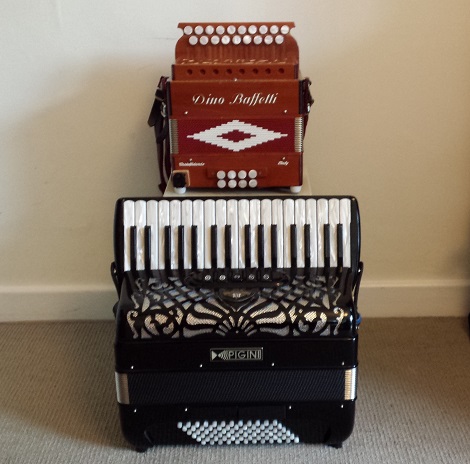Given the name of the blog, it seems appropriate that an early article should look at how I, as a player of both accordion and melodeon, feel about them as related but quite different instruments. I have done this through the followings lists of “likes and limits”. I end the article by providing a number of twin recordings showing where they can both do the same job well.
What I like about the piano accordion:
- All the treble notes for everything, and you can play in any key you wish
- All twelve bass notes enabling any bass runs
- Wide range of bass/chord combinations
- Less bellows effort than melodeon’s push/pull on fast tunes
- Large enough body to give some resonance to the sound (I find larger melodeons hard work to play)
- I can read music straight on to the piano keyboard (but not the melodeon, for which I have to get the tune in my head first)
More challenging aspects of piano accordion:
- You have to work harder to get near to the sort of liveliness, bounce and expression that comes much more naturally on a melodeon
- My accuracy on accordion is sometimes less than I would wish, and I tend to play looking at the keyboard (which I would prefer not to do, if only for appearances sake); I do not have this problem on melodeon.
What I like about the melodeon:
- The intrinsic liveliness, bounce and expression that comes naturally with the bellows push/pull
- I love being able to play it totally intuitively
- It is relatively easy to do chording and multi-noting on the treble as the notes are mostly in harmony on both the push and the pull
- The limitations of the melodeon design can lead you to musically interesting effects (eg different combinations of bass notes and chords)
- It is smaller and lighter to cart around than an accordion
Limitations of the melodeon (for me):
- The smaller melodeons give the greatest playability, but their body size do not give the richest sound
- The smaller melodeons do not always have all the notes and accidentals one would wish
- Getting a melodeon big enough to give the richest sound starts to impact on the playability, and can require quite a bit of strength to maintain the pushing and pulling that gives the bounce
- You can only play in a limited number of keys on any one melodeon
- I can play much more complicated tunes on accordion than on melodeon. I can also play tunes faster on accordion, and can play slow tunes more expressively
I find some tunes go better on accordion (eg Scottish reels) and some better on melodeon (eg polkas and hornpipes). But there is also a sizeable middle ground where they can both do a good job. To illustrate this I have compiled the following twin recordings.
(A) (M) Portobello + Linhope Lope
(A) (M) Hunt the Squirrel + Fiery Clockface
(A) (M) ‘Irish Reels’
(A) (M) Family’s Pride + Badunga
(A) (M) The Sands of Kersal (a slow air)
(A) (M) 2 SKINT Scottisches by Stony Steiner

